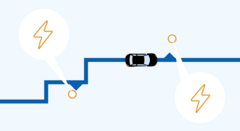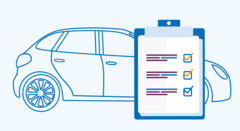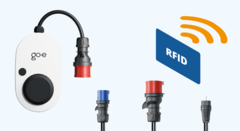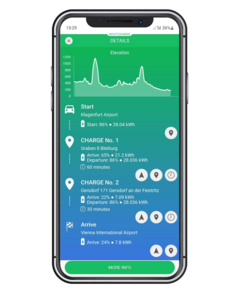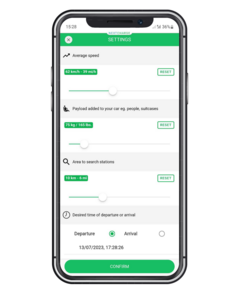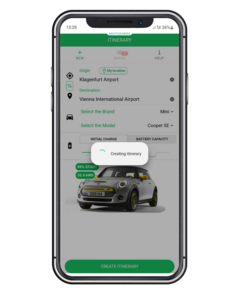How to Plan an EV Road Trip?
Suitcases are packed, and you’re looking forward to spending some lovely time enjoying the seaside, camping surrounded by nature or exploring culture and food in a new country. The future seems bright as ever.
Wait a minute.
Are you going there with an electric car? In that case, it might require a bit of planning. Don't worry, we've got you covered with some handy tips.
While your journey may not be drastically different from travelling with a traditional petrol car, a little extra preparation certainly won't hurt.
What Electric Cars Suit for Long Travels
Theoretically, you can travel with any electric car.
We once mentioned a man who travelled with Renault Twizy from Munich to the North Cape (around 3700 km). That was extreme! The car has a 5.8 kWh battery and about 80 km range. You can only imagine how many stops that traveller had to make in order to reach his destination.
To drive comfortably and avoid that itchy feeling called range anxiety, you need two things:
-
certainty that you will have super-fast charging stations along your route
-
a vehicle with at least 250 km range.
The second point is subjective, though.
If you are planning to rent an electric car for your trip, here are some more models that can offer you a worry-free travelling experience:
| EV model | Range |
|---|---|
| Renault Megane E-Tech | Up to 470 km |
| Hyundai IONIQ 5 | Up to 481 km |
| Audi e-tron GT quattro | Up to 501 km |
| Tesla Model 3 | Up to 602 km |
| BMW iX xDrive40 | Up to 630 km |
If you don’t mind stopping for charging every 2-3 hours, you can, of course, pick a car with a shorter range. Here are a few examples.
| EV model | Range |
|---|---|
| Smart EQ Fortwo | Up to 159 km |
| Honda e | Up to 222 km |
| Dacia Spring | Up to 230 km |
| BMW Mini Cooper SE | Up to 232 km |
| Fiat 500e Cabrio | Up to 322 km |
Some say plug-in hybrids, like the Toyota Prius Plug-in, Chevrolet Volt, and BMW i3 REx, offer a middle ground for those unsure about the limited range of electric cars or who want flexibility on longer trips. This is because they can switch to the combustion engine when the battery runs out.
But!
Plug-in hybrids are heavier as they have two motors AND a battery. This means they guzzle more fuel when using the combustion engine. Plus, their electric range is normally short. So, if you're not recharging every 100 km or less, driving long distances in a plug-in hybrid doesn't really make sense. On top of that, plug-in hybrids aren't as eco-friendly as electric cars because they still rely on fossil fuels, contributing to air pollution and climate change. All in all, a pure all-electric car is a better alternative for long distances.
Charging power capabilities of the electric cars
If you want to keep your stops short on your road trips, it's helpful to know about the charging capabilities of your electric car. Each model has its own power limits for charging.
Let’s imagine, you mostly plan to stop at AC public charging stations. For comparison, the Hyundai IONIQ 5 can charge at a maximum power of 11 kW at an AC charging station, while the Renault ZOE offers a maximum AC charging power of 22 kW. Even though the range and battery sizes may differ, the Renault ZOE is likely to charge more kilometres per hour of charging compared to the Hyundai IONIQ 5.
DC or AC Charging?
On a long road trip, DC fast charging is like a dream came true. For comparison, while with AC 11 kW charging station you can charge BMW iX3 from 50 to 80% in about 2 h, with a DC 150 kW charging station you can do the same thing in just 5-10 min. These calculations differ from one car model to another as every electric vehicle has its own max charging speed, but you get the picture, right?
We know, we know. It was mentioned quite a few times in our blog that DC charging is not healthy for your vehicle. DC charging means power fills in your car super fast and this process is pretty exhausting for the battery.
That being said, it doesn’t mean that every stop for rapid charge will cut a year of your battery life. If you need a super quick charge, just go for it.
Our advice is to not go overboard with it, even though it's super tempting during those long EV road trips. Instead, think ahead and come up with some nice things to do while your car charges at those AC public charging stations.
Planning a Cross Country Trip with an Electric Car Step by Step
In this guide, we'll take you through the essential steps to ensure a pleasant trip experience.
Step 1: Put your travel preferences first
Have you already decided on your final destination? Then, it’s time to plan how you’re gonna get there. Do the initial route planning based on the scenery you want to see, the cities you want to drive through, or perhaps special points you want to visit along the way (e.g. parks, zoos or museums).
Step 2: Ensure you have charging points conveniently located along your path
At this point, you might need to adjust your plan slightly, but no significant changes are normally needed unless you’re travelling through a desert.
Step 3: Identify and mark your stopping points
When driving, you can simply use the navigation system that's already built into your vehicle to find charging stations. You don't fancy the built-in system? Or maybe you just like the idea of having a detailed itinerary for your upcoming trip with all the stops marked? Try dedicated apps or websites designed specifically for electric car travel. We have listed the most common ones below. These tools can help you locate and map the optimal stops for charging your vehicle during the journey.
Step 4: Get to know the process of charging your car
Before you hit the road, make sure you know how to use the charging stations and what kind of cable you might need for your electric car. It'll save you time and hassle when you actually arrive at the charging spots.
Step 5: Take the essentials with you
Since most public AC charging stations do not have charging cables, it's a good idea to drop a type 2 cable in the back of your car. Also, don't forget to bring your RFID card from a public charging network operator if you have one. These simple things will help make your charging experience smoother.
Step 6: Do financial planning
Learn about charging costs to make informed choices. For instance, Ronald and Johannes, our e-mobility enthusiasts, paid only 29 cents/kWh and 13 EUR/month with Hyundai's special tariff on their trip from Austria to Norway.
Without using the tariff, they would have paid 79 cents/kWh. Quite a difference, huh?
Step 7: Estimate how long it will take you to charge at each stop
Use charging apps or websites to get an idea of how much time you'll need to charge your electric car at each stop. This way, you can plan your breaks and schedule accordingly.
Best Mobile Apps for EV Route Planning
Driving an electric car and hoping you will find a charging station as you go is… well… adventurous, but planning might offer you a more relaxing journey. Some mobile apps are a real help. Just a few clicks, and you have your road all planned, with stops to charge your car and coffee or lunch to recharge your inner battery.
Sounds good?
Have a look at the options we picked for you. All the apps can be used to find charging points, activate the charging process and pay for it. But what makes them different?
Unlike many other apps that simply show you the place located right next to the charging point, ChargeFinder gives you a detailed list of points of interest nearby, like restaurants, museums, supermarkets, and the distance to them. Change the map overview to satellite mode and see more of the road and landscapes of your future journey.
In this app, you can search for a charging point by plug type, charging speed, food, bathroom, parking lot, shopping, grocery store, etc. Build some nice routes for your upcoming journey at plugshare.com, and they will show up in the app. Sadly, you can’t do the route building directly in the app.
nextcharge is one more app that makes it possible to create a route taking into account charging points on the way. Here, you can do it right in the app. Enter your car model, departure/arrival points, average speed, number of passengers, and other details. You will then receive a personalised itinerary based on all your charging preferences and accurate calculations of the expected battery level at different points in the journey.
IONITY
Unlike the previous options, IONITY has its own network of charging points and shows them in the app. You can find IONITY chargers in 24 European countries. The charging provider comprises various automotive groups such as BMW, Daimler, Volkswagen, Ford, and Hyundai, offering special tariffs for the drivers. Electric cars from these member brands charge at around €0.30/kWh rate plus a small monthly fee, which makes IONITY charging perfectly affordable (30.06.2023). The app allows you to find charging stations, start charging and track the whole process while enjoying your coffee or exploring the area nearby.
EV route planning with Google Maps
You use Google Maps to find a way from home to that new restaurant in town? Then why not use it to look for charging stations when travelling to another country, right? If your car has its own built-in navigation system you’re happy with, just skip this part. But if you prefer the good old familiar interface of Google Maps, no problem.
The only thing is, you can’t simply use the app on your phone for route planning. You need to have Google Maps built into your vehicle. So far, Google apps and services are integrated into General Motors, Honda, Polestar, Renault and Volvo electric cars.
Google Maps easily teams up with compatible EVs and monitors your battery levels, energy usage, and other important stats. It can even predict your battery status when you reach your destination.
No need to stress about manually adjusting settings while driving. Many of these features work automatically, so you can relax on the road. For example, if Google detects that you'll need a charging station along your route, it will prompt you to add it without any extra effort on your part.
It goes the extra mile by showing you if places like museums have charging stations right there on the premises. So when you search for "Museum" on your car display, keep an eye out for a nifty little charging station icon below the address and alongside the place's rating.
What is the best Tesla route planner?
Most apps for finding charging stations show Tesla Superchargers on the way. But honestly, Tesla's own app is the most convenient option. Synchronised with the car, it calculates your recharging needs and maps suitable routes specifically tailored to Tesla Superchargers. Whether you're planning ahead or making a spontaneous trip, the app guides you to the nearest charging points, providing you with peace of mind.
4 Tips for Long Travels with an Electric Car
Travelling long distances with an electric car is easy. But if you make a little preparation, it will be even more fun. Here are some tips from our go-e team.
1. Get ready to travel with no rush
Charging an electric car often takes longer than refuelling a traditional vehicle. Charging time depends a lot on the kind of charging station you choose, car battery size, car charging capabilities and state of the battery. For instance, at an HPC (high power charging) 350 kW station, you can charge the Hyundai IONIQ 5 (72.6 kWh) from 10 percent to 80 percent in just 18 minutes. In the meantime, with an 11 kW AC charger, you will be able to get the same amount of power in more than 4 hours.
2. Avoid creating a precise schedule
Keep in mind that not all charging stations are going to be available. For example, some might be occupied when you reach them. So, it's best not to create a tight schedule for charging. Don’t wait until your battery is nearly empty, and be prepared for unexpected situations.
3. Bring a mobile wallbox with you
Visiting friends on the way to your destination? Planning to spend a few nights at a campsite? A mobile wallbox, like our go-e Charger Gemini flex allows you to take it with you and charge your electric car from a red CEE socket wherever you are. This way, your charging will be financially beneficial. And don't worry if you can't find a red CEE socket, you can still plug it into a blue CEE outlet or even a regular 220V socket with the right go-e adapter. Just keep in mind that charging will be slower in the latter case.
go-e Charger Gemini 11 kW
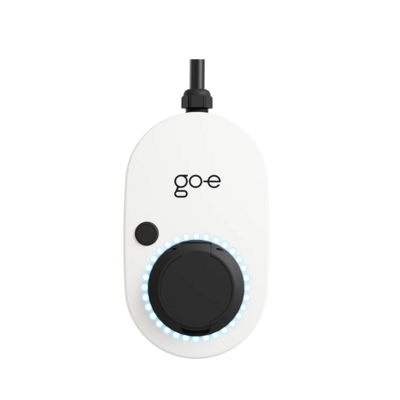
The compact wallbox for stationary use, at home or at the workplace. Simple installation, intuitive operation and smart comfort functions. Charging power from 1.4 kW to 11 kW. 1-phase or 3-phase charging.
go-e Charger Gemini 22 kW
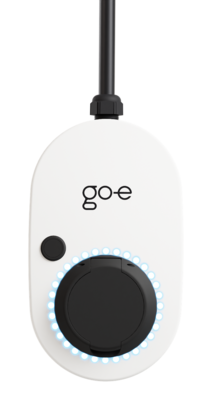
The compact wallbox for stationary use, at home or at the workplace. Simple installation, intuitive operation and smart comfort functions. Charging power from 1.4 kW to 22 kW. 1-phase or 3-phase charging.
4. Look for hotels with charging stations
Many hotels these days are offering EV charging stations to guests for free or at special rates. Just imagine this: you're about to arrive at your hotel late in the evening and realise your car battery is running dangerously low. If you know the hotel has charging facilities, you can relax knowing you can top up overnight. Otherwise, you'll have to make a detour to charge up, which isn't the most exciting thing to do when you're already tired from driving.
How do I Maximise my EV Highway Range?
Even though there are plenty of public charging stations available, you don’t want to stop too often. What can you do to drive with maximum efficiency?
Maintain a steady speed: Frequent acceleration and deceleration can drain your battery faster. Therefore, consistency is key when it comes to maximising your EV's range. Use cruise control if your EV is equipped with it, as it helps to maintain a constant speed.
Take it slow: Avoid excessive speed and stick to a cruising pace of around 120 to 130 km/h. If you push it beyond 140 km/h or higher, you might notice a significant drop in your battery's capacity. So slow down and enjoy the ride.
Use eco-mode or range mode: Many EVs come with eco-mode or range mode options. These modes optimise various vehicle settings, such as throttle response, climate control, and power consumption, to maximise efficiency. Engage these modes to extend your range.
Utilise regenerative braking: When you take your foot off the pedal to slow down or brake, the so-called regenerative braking system kicks in, capturing and storing that energy instead of letting it go to waste. Some car models, like Škoda Enyaq iV, have advanced regenerative braking allowing the vehicle to slow down as soon as the driver lifts their foot off the accelerator pedal without having to press on the brake pedals. This way, more energy is recaptured during deceleration.
Minimise unnecessary energy consumption: If the battery is nearly full and there is no charging station nearby, reduce energy consumption by turning off non-essential features like heated seats or high-powered audio systems. Also, unplug any gadgets that you're not using to avoid wasting precious battery power.
Precondition your EV: If your EV has a preconditioning feature, use it while your vehicle is still plugged in before starting your journey. That way, you won't be draining your battery while you drive and you'll be all set to go in comfort.
Charge to a higher level: If possible, charge your EV to a higher state of charge before starting your trip. Starting off with a fuller battery gives you a bigger safety net and lets you make the most of your ride.
Summary
Planning an electric car journey calls for some extra steps, but with the right preparation, it can be a hassle-free experience. Use apps like nextcharge, PlugShare or even Google Maps to find charging stations and plan your stops in advance. Already on your way to your dream destination? Simply use the navigation system in your car to find where the next charging station is.
If you’re going to make a few stops for AC charging, plan where to spend longer breaks and remember to bring a charging cable with you. Opt for electric cars with good range and try to drive efficiently by maintaining an optimal speed, using eco-mode, and regenerative braking.
If you have access to a power outlet on your way, charge with the go-e Charger Gemini flex and save the cost of every kilowatt.
With these and other tips in your pocket, you're all set for a great electric road trip!
go-e newsletter subscription
Stay informed about go-e and the latest developments and innovative solutions in e-mobility and charging technology.

